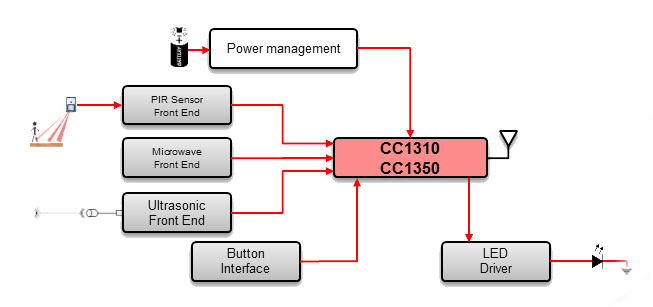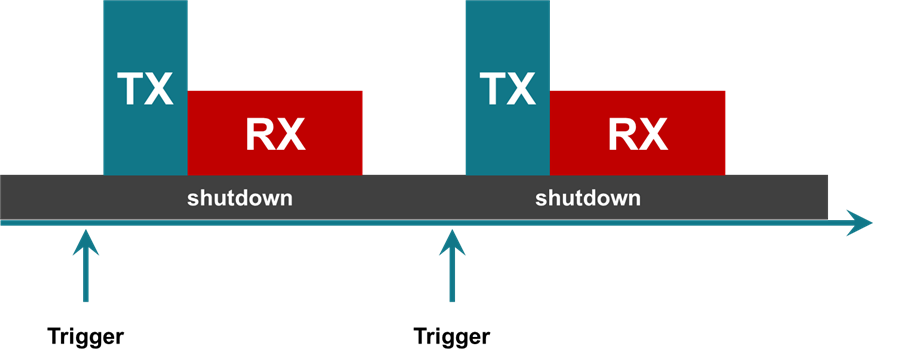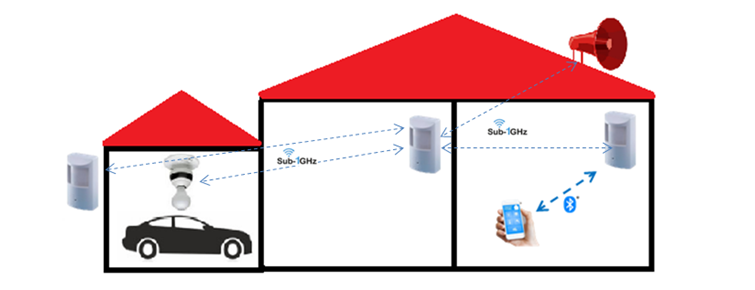Designing with the SimpleLink Sub-1 GHz wireless MCU
As part of the SimpleLink™ microcontroller (MCU) platform, TI’s system-on-chip (SoC) Sub-1 GHz solutions (CC13x0 wireless MCUs) provide a low-power and peripheral-rich MCU with an integrated RF solution on a single
chip. In a sensor system (as seen in Figure 1 below), the low-power wireless MCU operates as the main MCU for the system, either interfacing directly
with the sensors or through an amplifier, filter or comparator. The CC1350 and CC1310 wireless MCUs also have Inter-Integrated Circuit (I2C), universal synchronous receiver/transmitter (UART) or Serial Peripheral Interface (SPI)
for controlling peripherals and a 12-bit analog-to-digital converter (ADC) for analog signal sampling.
By choosing a SoC wireless MCU instead of a chipset solution (a separate MCU and RF transceiver), you can achieve better integration, size and cost. The primary MCU is based on the ARM® Cortex®-M3 architecture,
which contains enough flash and RAM for your application and protocols.
Low power
Extremely low shutdown or standby current modes (0.185µA and 0.7µA, respectively), 51µA/MHz million-instruction-per-second (MIPS) consumption, and receiver (5.4mA) and transmitter (13.4mA at 10dBm) currents
establish the foundation for low-power design. Additionally, a novel low-power execution unit known as sensor-controller module monitors sensors while the rest of the system (the main MCU) remains asleep. This enables the system to consume
as little as 0.95µA with an ADC reading every second.
In a typical motion-detector system, the sensor controller monitors sensors continuously. As can be seen in the below figure, once triggered, the controller wakes up the main MCU, which then transmits a notification
to a central unit.
Software
The SimpleLink Sub-1 GHz CC13x0 software development kit (SDK) provides two easy options for RF communication. The first option is called Easylink, which is a proprietary RF interface using one of many supported
modulations and a standards-based 802.15.4g stack for a star topology. With Easylink, you can use your own protocol and add motion detectors to existing wireless systems.. If you don’t have a proprietary protocol the TI 15.4 stack is
probably the better fit for you. Its standard access mechanism includes acknowledgment, security features and a frequency-hopping option – tools that can help you protect against RF jamming, cyberattacks and noisy environments. TI also
provides an end-to-end sensor-to-cloud solution that enables two-way communication between the sensor nodes, and a cloud provider for monitoring and control.
Dual-mode systems
The CC1350 wireless MCU supports both Sub-1 GHz and Bluetooth® low energy connectivity. The addition of Bluetooth low energy connectivity opens up options for new and advanced applications. Bluetooth low
energy technology adds a native user interface to the motion detector system (at minimal cost), so end users can communicate with each smart device directly to set configurations and pull information from throughout the system. Figure 3 illustrates a house with several motion detectors. These sensors are all forming a Sub-1 GHz network to connect to both each other and the
alarm siren. But because these devices also have Bluetooth low energy connectivity, they are accessible with a smartphone or tablet.
System management using Bluetooth low energy
To set up this system, a phone or tablet connects to the motion detector via Bluetooth low energy and transmits network properties and security credentials for the Sub-1 GHz network. Once the network configuration
is complete, the motion detector switches to Sub-1 GHz mode and connects to the Sub-1 GHz network. You can use the phone or tablet interface to configure many other aspects of the motion sensor such as detection modes, sensitivity,
day-specific modes and more. You can also easily test the system by checking the network status on your phone without waiting for the alarm to sound.
Connecting to mobile applications via Bluetooth low energy also makes it easy to push software updates to any part of the system, keeping it up to date and bug-free. Just release an update, push it to your mobile
app users and they will get a notification to upgrade their system.
Lastly, Bluetooth low energy supports the advertisement feature. With advertisement, the motion detector can transmit notifications to a nearby phone in a connectionless mode, pushing notifications like battery status or network issues to
the end user automatically.
 Figure 1 Wireless motion detector block diagram
Figure 1 Wireless motion detector block diagram Figure 2 Typical Use Case Profile
Figure 2 Typical Use Case Profile Figure 3 Wireless Motion Detector System with Bluetooth Low Energy
Figure 3 Wireless Motion Detector System with Bluetooth Low Energy